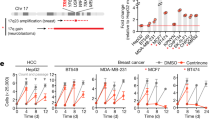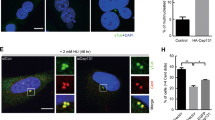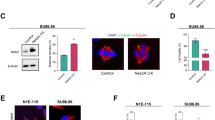Abstract
The serine/threonine-specific casein kinase I delta (CKIδ) is ubiquitously expressed in all tissues, is p53 dependently induced in stress situations and plays an important role in various cellular processes. Our immunohistochemical analysis of the human placenta revealed strongest expression of CKIδ in extravillous trophoblast cells and in choriocarcinomas. Investigation of the functional role of CKIδ in an extravillous trophoblast hybrid cell line revealed that CKIδ was constitutively localized at the centrosomes and the mitotic spindle. Inhibition of CKIδ with the CKI-specific inhibitor IC261 led to structural alterations of the centrosomes, the formation of multipolar spindles, the inhibition of mitosis and, in contrast to other cell lines, the induction of apoptosis. Our findings indicate that CKIδ plays an important role in the mitotic progression and in the survival of cells of trophoblast origin. Therefore, IC261 could provide a new tool in treating choriocarcinomas.
This is a preview of subscription content, access via your institution
Access options
Subscribe to this journal
Receive 50 print issues and online access
$259.00 per year
only $5.18 per issue
Buy this article
- Purchase on Springer Link
- Instant access to full article PDF
Prices may be subject to local taxes which are calculated during checkout









Similar content being viewed by others
Abbreviations
- CKIδ:
-
casein kinase I delta
- DAPI:
-
4,6-diamidine-2-phenylindole hydrochloride
- FCS:
-
fetal calf serum
- mdm2:
-
mouse double minute 2
References
Bamberger AM, Bamberger CM, Wald M, Jensen K and Schulte HM . (1997). Endocrine, 6, 111–116.
Behrend L, Milne DM, Stoter M, Deppert W, Campbell LE, Meek DW and Knippschild U . (2000a). Oncogene, 19, 5303–5313.
Behrend L, Stoter M, Kurth M, Rutter G, Heukeshoven J, Deppert W and Knippschild U . (2000b). Eur. J. Cell. Biol., 79, 240–251.
Beyaert R, Vanhaesebroeck B, Declercq W, Van Lint J, Vandenabele P, Agostinis P, Vandenheede JR and Fiers W . (1995). J. Biol. Chem., 270, 23293–23299.
Bischof P and Campana A . (2000). Hum. Reprod., 15 (Suppl. 6), 51–58.
Bornens M and Moudjou M . (1999). Methods Cell Biol., 61, 13–34.
Brockman JL, Gross SD, Sussman MR and Anderson RA . (1992). Proc. Natl. Acad. Sci. USA, 89, 9454–9458.
Chakraborty C, Gleeson LM, McKinnon T and Lala PK . (2002). Can. J. Physiol. Pharmacol., 80, 116–124.
Desagher S, Osen-Sand A, Montessuit S, Magnenat E, Vilbois F, Hochmann A, Journot L, Antonsson B and Martinou JC . (2001). Mol. Cell, 8, 601–611.
Dhillon N and Hoekstra MF . (1994). EMBO J., 13, 2777–2788.
Dumaz N, Milne DM and Meek DW . (1999). FEBS Lett., 463, 312–316.
Dumont P, Leu JI, Della Pietra III AC, George DL and Murphy M . (2003). Nat. Genet., 33, 357–365.
Fish KJ, Cegielska A, Getman ME, Landes GM and Virshup DM . (1995). J. Biol. Chem., 270, 14875–14883.
Frank HG, Gunawan B, Ebeling-Stark I, Schulten HJ, Funayama H, Cremer U, Huppertz B, Gaus G, Kaufmann P and Fuzesi L . (2000). Cancer Genet. Cytogenet., 116, 16–22.
Funayama H, Gaus G, Ebeling I, Takayama M, Füzesi L, Huppertz B, Kaufmann P and Frank HG . (1997). Placenta; Suppl. Trophoblast Res., 10, 191–201.
Ghadimi BM, Sackett DL, Difilippantonio MJ, Schrock E, Neumann T, Jauho A, Auer G and Ried T . (2000). Genes Chromosomes Cancer, 27, 183–190.
Graves PR, Haas DW, Hagedorn CH, DePaoli-Roach AA and Roach PJ . (1993). J. Biol. Chem., 268, 6394–6401.
Gross SD and Anderson RA . (1998). Cell Signal., 10, 699–711.
Izeradjene K, Douglas L, Delaney AB and Houghton JA . (2004). Cancer Res., 64, 8036–8044.
Kalderon D . (2002). Trends Cell Biol., 12, 523–531.
Knippschild U, Gocht A, Wolff S, Huber N, Lohler J and Stoter M . (2005). Cell Signal., 17, 675–689.
Knippschild U, Milne D, Campbell L and Meek D . (1996). Oncogene, 13, 1387–1393.
Knippschild U, Milne DM, Campbell LE, DeMaggio AJ, Christenson E, Hoekstra MF and Meek DW . (1997). Oncogene, 15, 1727–1736.
Ling YH, Tornos C and Perez-Soler R . (1998). J. Biol. Chem., 273, 18984–18991.
Lingle WL, Lutz WH, Ingle JN, Maihle NJ and Salisbury JL . (1998). Proc. Natl. Acad. Sci. USA, 95, 2950–2955.
Marchal C, Dupre S and Urban-Grimal D . (2002). J. Cell Sci., 115, 217–226.
Maritzen T, Lohler J, Deppert W and Knippschild U . (2003). Eur. J. Cell Biol., 82, 369–378.
Martin-Subero JI, Knippschild U, Harder L, Barth TF, Riemke J, Grohmann S, Gesk S, Hoppner J, Moller P, Parwaresch RM and Siebert R . (2003). Leukemia, 17, 2214–2219.
Mashhoon N, DeMaggio AJ, Tereshko V, Bergmeier SC, Egli M, Hoekstra MF and Kuret J . (2000). J. Biol. Chem., 275, 20052–20060.
McKay RM, Peters JM and Graff JM . (2001). Dev. Biol, 235, 388–396.
Milne DM, Looby P and Meek DW . (2001). Exp. Cell Res., 263, 43–54.
Murakami A, Kimura K and Nakano A . (1999). J. Biol. Chem., 274, 3804–3810.
Nicoletti I, Migliorati G, Pagliacci MC, Grignani F and Riccardi C . (1991). J. Immunol. Methods, 139, 271–279.
Okamura A, Iwata N, Nagata A, Tamekane A, Shimoyama M, Gomyo H, Yakushijin K, Urahama N, Hamaguchi M, Fukui C, Chihara K, Ito M and Matsui T . (2004). Blood, 103, 2997–3004.
Panek HR, Conibear E, Bryan JD, Colvin RT, Goshorn CD and Robinson LC . (2000). J. Cell Sci., 113 (Part 24), 4545–4555.
Pihan GA, Purohit A, Wallace J, Knecht H, Woda B, Quesenberry P and Doxsey SJ . (1998). Cancer Res., 58, 3974–3985.
Pim D and Banks L . (2004). Int. J. Cancer, 108, 196–199.
Robinson LC, Menold MM, Garrett S and Culbertson MR . (1993). Mol. Cell. Biol., 13, 2870–2881.
Rowles J, Slaughter C, Moomaw C, Hsu J and Cobb MH . (1991). Proc. Natl. Acad. Sci. USA, 88, 9548–9552.
Sakaguchi K, Saito S, Higashimoto Y, Roy S, Anderson CW and Appella E . (2000). J. Biol. Chem., 275, 9278–9283.
Thomas M, Kalita A, Labrecque S, Pim D, Banks L and Matlashewski G . (1999). Mol. Cell. Biol., 19, 1092–1100.
Tuazon PT and Traugh JA . (1991). Adv. Second Messenger Phosphoprotein Res., 23, 123–164.
Urbani L and Stearns T . (1999). Curr. Biol., 9, R315–R317.
Vielhaber E and Virshup DM . (2001). IUBMB Life, 51, 73–78.
Winter M, Milne D, Dias S, Kulikov R, Knippschild U, Blattner C and Meek D . (2004). Biochemistry, 43, 16356–16364.
Yagel S, Parhar RS, Jeffrey JJ and Lala PK . (1988). J. Cell. Physiol., 136, 455–462.
Zhai L, Graves PR, Robinson LC, Italiano M, Culbertson MR, Rowles J, Cobb MH, DePaoli-Roach AA and Roach PJ . (1995). J. Biol. Chem., 270, 12717–12724.
Zhang J, Gross SD, Schroeder MD and Anderson RA . (1996). Biochemistry, 35, 16319–16327.
Zhao Y, Qin S, Atangan LI, Molina Y, Okawa Y, Arpawong HT, Ghosn C, Xiao JH, Vuligonda V, Brown G and Chandraratna RA . (2004). J. Biol. Chem., 279, 30844–30849.
Zimmerman W, Sparks CA and Doxsey SJ . (1999). Curr Opin Cell Biol, 11, 122–128.
Acknowledgements
We thank our colleague Dr Heukeshoven for the synthesis of the CKIδ-specific peptide 108. We also thank Solveig Aupers for technical advice on histological techniques, Dr Lars Behrend for his help in using the adenoviral p53 knockdown expression system and J Koppelmeyer for help with photographic work. Furthermore, we thank Professor Dr Günter Klöppel and PD Dr Peter Würl for helpful discussions and reading the manuscript. This work was supported by grants from the Deutsche Krebshilfe, Dr Mildred Scheel Stiftung, to Uwe Knippschild (10-1683-KN2 and 10-2237-KN3) and from the Deutsche Forschungsgemeinschaft to Hans-Georg Frank and Peter Kaufmann (Fr1245/3-3 and 4). The Heinrich Pette Institut is financially supported by Freie Hansestadt Hamburg and Bundesministerium für Gesundheit. This work is part of the PhD thesis of Martin Stöter, Fachbereich Biologie at the University of Hamburg.
Author information
Authors and Affiliations
Electronic supplementary material
Rights and permissions
About this article
Cite this article
Stöter, M., Bamberger, AM., Aslan, B. et al. Inhibition of casein kinase I delta alters mitotic spindle formation and induces apoptosis in trophoblast cells. Oncogene 24, 7964–7975 (2005). https://doi.org/10.1038/sj.onc.1208941
Received:
Revised:
Accepted:
Published:
Issue Date:
DOI: https://doi.org/10.1038/sj.onc.1208941
Keywords
This article is cited by
-
Combinatorial regulation by ERK1/2 and CK1δ protein kinases leads to HIF-1α association with microtubules and facilitates its symmetrical distribution during mitosis
Cellular and Molecular Life Sciences (2024)
-
State-dependent block of voltage-gated sodium channels by the casein-kinase 1 inhibitor IC261
Investigational New Drugs (2017)
-
Discovery of potential neurodegenerative inhibitors in Alzheimer’s disease by casein kinase 1 structure-based virtual screening
Medicinal Chemistry Research (2017)
-
Casein kinase 1α has a non-redundant and dominant role within the CK1 family in melanoma progression
BMC Cancer (2016)
-
Alternative splicing within the Wnt signaling pathway: role in cancer development
Cellular Oncology (2016)



